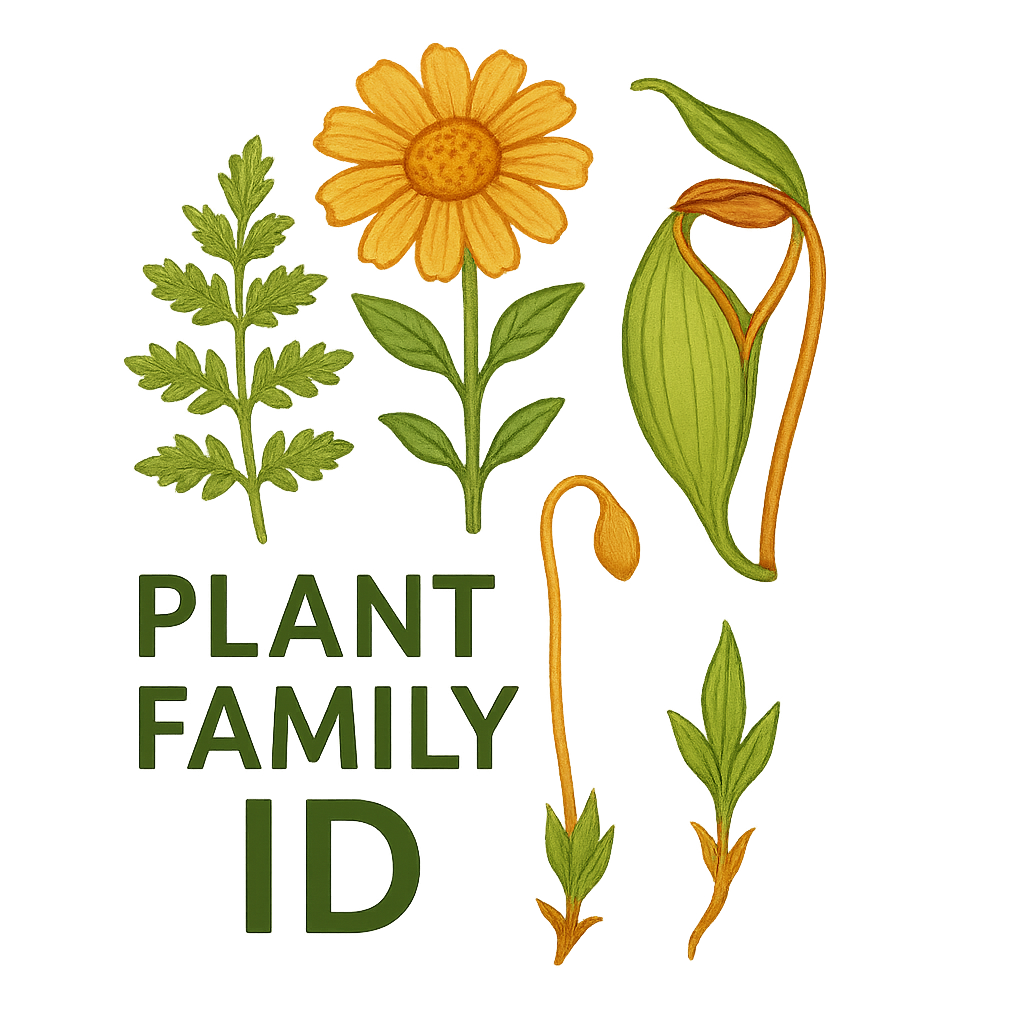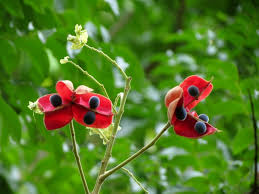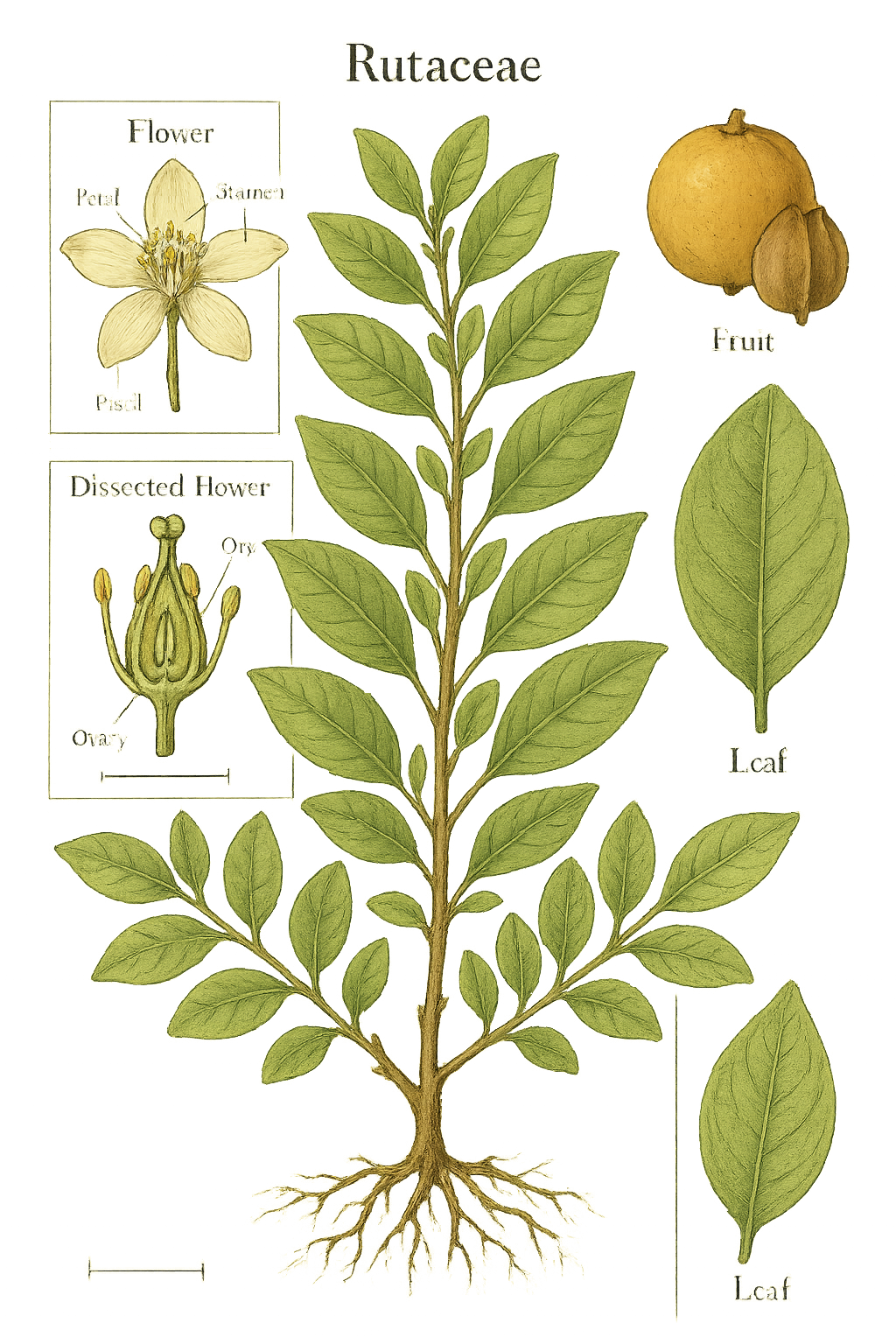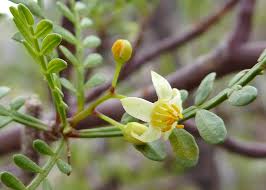Anacardiaceae
Cashew / Sumac Family
Anacardiaceae is a large family of flowering plants in the order Sapindales, primarily comprising trees and shrubs, distributed mainly in tropical regions but also extending into temperate zones. The family is well-known for economically important species like mango, cashew, and pistachio, but also includes notorious allergenic plants such as poison ivy, poison oak, and poison sumac due to resins containing urushiol. Resin ducts in the bark and leaves are characteristic.
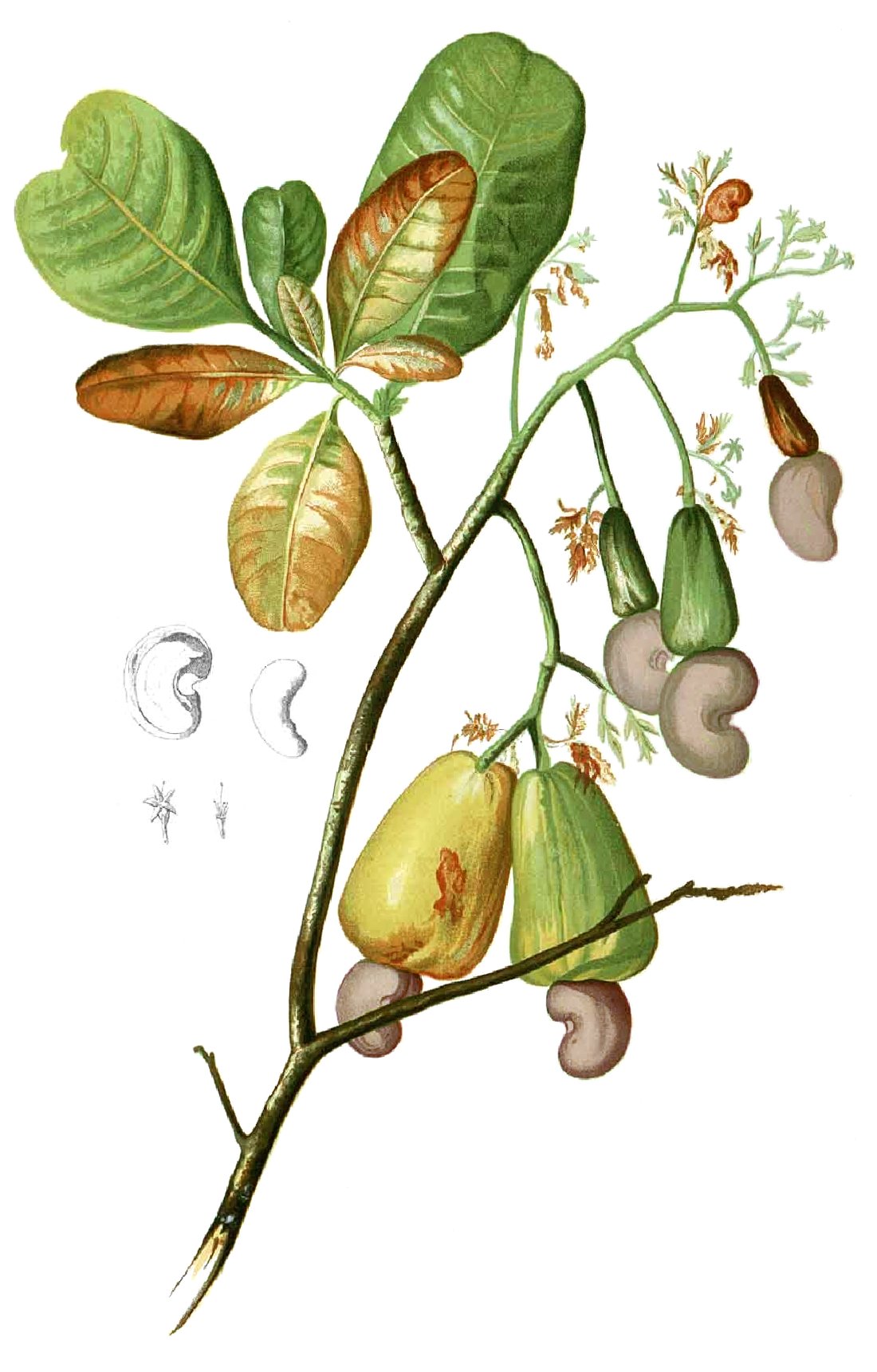
Overview
The Anacardiaceae family includes about 70-82 genera and roughly 800-860 species of trees, shrubs, and sometimes lianas. It has a pantropical distribution, with significant diversity in Malesia, tropical America, and Africa, but also extends well into temperate regions of North America and Eurasia. Members typically possess resin canals in their bark and leaves, which produce clear, milky, or blackish resins or latex. These resins can be aromatic, economically useful (e.g., varnishes, tannins, mastic), or highly irritant/allergenic.
Vegetatively, the family is often recognized by its usually alternate and pinnately compound leaves, although simple or trifoliate leaves also occur. Flowers are generally small, typically 5-merous, often unisexual, and borne in conspicuous terminal or axillary panicles. A prominent nectar disc is usually present within the flower. The fruit is characteristically a drupe (fleshy with a hard stone), which is often laterally compressed or kidney-shaped and may have complex structures, as seen in the cashew.
Anacardiaceae holds immense economic and cultural importance. It provides major edible fruits and nuts like mango (Mangifera indica), cashew (Anacardium occidentale), and pistachio (Pistacia vera). Other species yield valuable tannins, resins, lacquers (Toxicodendron vernicifluum), and timber. Several genera are grown as ornamentals (Cotinus, Rhus, Schinus). However, the family also includes highly problematic plants in the genus Toxicodendron (poison ivy, oak, sumac) whose urushiol-containing resin causes severe contact dermatitis in sensitized individuals.
Quick Facts
- Scientific Name: Anacardiaceae
- Common Name: Cashew family, Sumac family
- Number of Genera: Approximately 70-82
- Number of Species: Approximately 800-860
- Distribution: Pantropical, extending into subtropical and temperate regions worldwide
- Evolutionary Group: Eudicots - Rosids - Sapindales
- Current Date: March 29, 2025
Key Characteristics
Growth Form and Habit
Mostly trees and shrubs, some lianas. Resin ducts or canals containing clear, milky, or blackish resin (sometimes caustic/allergenic) are typically present in bark and leaves.
Leaves
Leaves are usually alternate (rarely opposite), and most commonly pinnately compound (odd- or even-pinnate), but sometimes trifoliate or simple. Leaflets typically have entire margins. Stipules are generally absent or minute.
Inflorescence
Flowers are usually arranged in terminal or axillary panicles, which are often large and branched. Less commonly, inflorescences are racemes or spikes. Flowers are numerous and typically small.
Flowers
Flowers are generally small, actinomorphic (radially symmetrical), and often unisexual (plants then dioecious, monoecious, or polygamous), though sometimes bisexual. Typically 5-merous (parts in fives).
- Calyx: Usually 5 sepals (3-7), distinct or fused at the base, often persistent.
- Corolla: Usually 5 petals (3-7 or absent), distinct, typically small and greenish, whitish, or yellowish.
- Nectar Disc: A prominent intrastaminal (inside the stamens) or extrastaminal nectar disc is usually present.
- Androecium: Stamens typically number 5 or 10 (sometimes fewer or more), often inserted on or around the disc. Filaments are distinct. Staminodes (sterile stamens) are often present in female flowers.
- Gynoecium: Ovary is usually superior (rarely partly inferior), typically composed of 1 or 3(-5) fused carpels. Often, only one carpel is fertile and develops, resulting in a functionally unilocular ovary containing a single ovule. Placentation is basal, apical, or lateral. Styles are usually 1 or 3(-5), distinct or fused. A pistillode (sterile pistil) is often present in male flowers.
Fruits and Seeds
The characteristic fruit is a drupe (a fleshy fruit with a hard inner layer, the stone or endocarp, enclosing the seed), like mango or pistachio. Drupes are often laterally compressed or kidney-shaped. Less commonly, the fruit may be a samara (winged dry fruit) or nut. The structure can be complex, as in the cashew where the 'nut' is the seed attached to a fleshy receptacle (cashew apple).
Typically contains a single seed. The seed usually lacks endosperm or has very sparse endosperm; the embryo is often large and curved.
Chemical Characteristics
The family is notable for producing phenolic resins, which can be clear, milky, or blacken upon exposure to air. In Toxicodendron and related genera, these resins contain urushiols, potent allergens causing severe contact dermatitis. Tannins are also common. Some species produce edible oils (cashew nut shell liquid is phenolic and caustic, but the kernel oil is edible). Aromatic compounds contribute to the flavor of mangoes and pistachios.
Field Identification
Identifying Anacardiaceae often involves looking for the combination of resin ducts, leaf arrangement and type, flower structure (especially the disc), and the characteristic drupe fruit:
Primary Identification Features
- Resin Ducts/Canals: Presence of resin (clear, milky, blackening) in cut bark or broken petioles (use caution - may be allergenic).
- Alternate, Compound Leaves (Usually): Leaves most often alternate and pinnately compound, though simple or trifoliate leaves occur in some important genera (Mangifera, Cotinus).
- Small Flowers in Panicles: Inflorescences typically large, branched panicles bearing numerous small flowers.
- Nectar Disc Present: A distinct fleshy disc is usually visible within the flower, typically surrounding the base of the ovary or stamens.
- Superior Ovary, Often Functionally 1-Carpel/1-Ovule: Ovary position and structure lead to single-seeded fruits.
- Fruit a Drupe (Typically): Fleshy fruit containing a single hard stone (e.g., mango, pistachio structure).
Secondary Identification Features
- Absence of Stipules (Usually).
- Unisexual Flowers Common: Plants often dioecious or polygamous.
- Flowers Typically 5-merous.
- Allergenic Potential: Be aware of potential skin irritation from resins, especially in Toxicodendron.
Seasonal Identification Tips
- Growing Season: Identify by tree/shrub/liana habit, alternate compound (or sometimes simple) leaves, and presence of resin ducts.
- Flowering Season: Spring to summer typically. Look for the large panicles of small, often greenish/whitish flowers; examine individual flowers for the nectar disc and number of parts.
- Fruiting Season: Summer through fall. The characteristic drupe fruits (mangoes, cashews, pistachios, poison ivy berries, sumac clusters) are often highly diagnostic.
Common Confusion Points
- Sapindaceae (Maple/Soapberry family): Also in Sapindales, includes many trees/shrubs with alternate compound leaves. Differ in lacking prominent resin ducts (though some have latex), often having zygomorphic flowers, and diverse fruit types (capsules, schizocarps, berries - maples have winged schizocarps).
- Rutaceae (Citrus family): Also in Sapindales. Often have compound leaves (pinnate, trifoliate, or appearing simple) but typically possess conspicuous pellucid dots (oil glands) in leaves, making them aromatic when crushed. Flowers usually have a prominent disc, but fruit types are different (hesperidium, capsule, samara, drupe).
- Burseraceae (Frankincense/Myrrh family): Also in Sapindales, trees/shrubs with resin ducts and often alternate pinnately compound leaves. Distinguished by typically having flowers with stamens arising outside the disc (or disc absent/cupular), and fruit usually a drupe or pseudo-capsule splitting to reveal a pyrene often covered by a pseudo-aril.
- Simaroubaceae (Tree-of-Heaven family): Also in Sapindales, trees/shrubs often with alternate pinnately compound leaves (e.g., Ailanthus). Differ in often having bitter bark/twigs, flowers sometimes lack petals, nectar disc often present but sometimes stalked, and fruit is typically a samara or schizocarp of samaras or drupes (not usually a single drupe).
- Juglandaceae (Walnut family): Trees with alternate pinnately compound leaves, but leaves often aromatic, flowers unisexual and inconspicuous (catkins), and fruit a large drupe-like nut in a husk.
Look for the combination of resin ducts, alternate compound leaves (usually), small 5-merous flowers with a disc in large panicles, and a drupe fruit.
Field Guide Quick Reference
Look For:
- Trees, shrubs, lianas with resin ducts
- Alternate, pinnately compound leaves (usually)
- No stipules (usually)
- Small flowers in large panicles
- Flowers 5-merous, often unisexual
- Prominent nectar disc
- Superior ovary, often 1 fertile carpel/ovule
- Fruit typically a drupe
Key Variations:
- Leaves: Simple, trifoliate, or pinnate
- Resin: Clear, milky, blackening, irritant vs non-irritant
- Sexuality: Bisexual, monoecious, dioecious, polygamous
- Fruit structure (e.g., cashew vs mango vs pistachio)
- Stamen number (often 5 or 10)
Notable Examples
Anacardiaceae includes species of major economic importance as well as infamous toxic plants:

Mangifera indica
Mango
A large evergreen tree native to South Asia, cultivated pantropically for its highly prized fruit, a large fleshy drupe. It has simple, alternate leaves and produces large terminal panicles of small, fragrant flowers. One of the world's most important tropical fruits.

Anacardium occidentale
Cashew
A tropical evergreen tree native to northeastern Brazil. It produces the cashew 'nut' (which is botanically the seed) attached below a fleshy, pear-shaped accessory fruit called the cashew apple. The shell surrounding the seed contains caustic cashew nut shell liquid (CNSL).

Pistacia vera
Pistachio
A small deciduous tree native to Central Asia and the Middle East, cultivated for its edible seeds (pistachio nuts). Plants are dioecious. Leaves are pinnately compound. The fruit is a drupe with a hard shell (endocarp) surrounding the greenish kernel.

Toxicodendron radicans
Poison Ivy
A notorious North American vine or shrub recognized by its characteristic trifoliate leaves ("leaves of three, let it be"). All parts contain urushiol, a resin that causes severe allergic contact dermatitis in most people. Produces clusters of small, whitish drupes.

Rhus typhina
Staghorn Sumac
A large shrub or small tree native to eastern North America, known for its densely hairy twigs resembling deer antlers in velvet. Leaves are pinnately compound. Produces dense, upright clusters (panicles) of fuzzy, reddish drupes used to make a lemonade-like drink. Non-poisonous, unlike Toxicodendron sumacs.

Schinus terebinthifolius
Brazilian Pepper Tree / Florida Holly
A shrub or small tree native to South America, widely introduced and often highly invasive in warm climates (e.g., Florida, California, Hawaii). Has pinnately compound leaves and produces abundant clusters of small, bright red drupes often used as 'pink peppercorns' (unrelated to true pepper).
Phylogeny and Classification
Anacardiaceae is a core family within the order Sapindales, which belongs to the malvid clade of rosid eudicots. This order is characterized by woody habits (mostly), often compound leaves, flowers typically possessing a nectar disc, and the production of various resins, oils, or alkaloids. It includes other economically important families like Sapindaceae (maples, lychee), Rutaceae (citrus), and Meliaceae (mahogany).
Molecular phylogenetic studies confirm the monophyly of Anacardiaceae and its placement within Sapindales. Its closest relatives within the order are generally considered to be Burseraceae (Frankincense and Myrrh family) and Kirkiaceae (a small African family). These three families form a well-supported clade. The internal phylogeny of Anacardiaceae is complex, but generally separates into two main subfamilies or clades, one primarily including genera like Spondias, and the other including Anacardium, Mangifera, Pistacia, Rhus, Toxicodendron, etc.
Position in Plant Phylogeny
- Kingdom: Plantae
- Clade: Angiosperms (Flowering plants)
- Clade: Eudicots
- Clade: Rosids
- Clade: Malvids
- Order: Sapindales
- Family: Anacardiaceae
Evolutionary Significance
Anacardiaceae is significant for several evolutionary and ecological reasons:
- Chemical Defense/Interaction: The evolution and diversification of resins, particularly urushiols, represent a potent chemical defense strategy, leading to complex interactions with herbivores and specialized adaptations in humans (allergies).
- Fruit Diversification: While typically drupes, the variations in fruit structure (e.g., cashew's accessory fruit, mango's fleshy mesocarp, pistachio's dehiscent pericarp) illustrate diverse pathways for seed dispersal syndromes.
- Economic Domestication: The family provides key examples of plant domestication for fruit, nuts, and industrial products from different geographic centers (Asia - mango; South America - cashew; Central Asia - pistachio).
- Tropical Dominance and Temperate Extension: Represents a primarily tropical lineage that has successfully radiated into temperate zones, offering insights into adaptations required for these transitions.
- Taxonomic Challenges: The historical difficulty in separating genera like Rhus and Toxicodendron highlights challenges in using morphology alone and the power of molecular data combined with chemical profiles.
